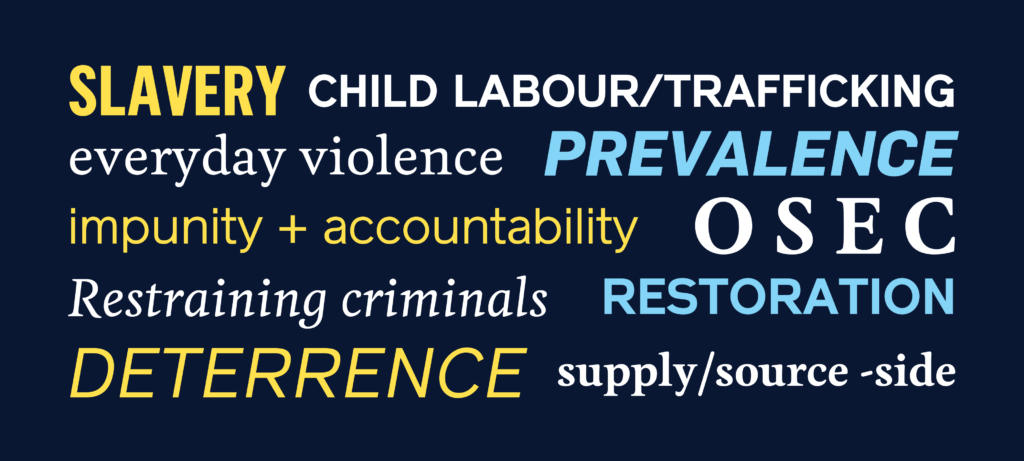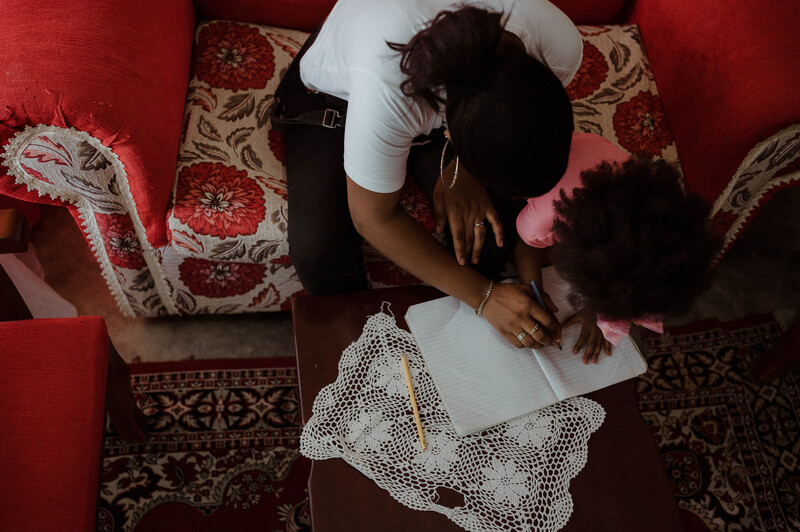
By Hsu-Ann Lee
When we talk to our supporters about IJM’s work, we try not to be overly technical about slavery and violence. While we do our best to avoid jargon, there are some words that carry very specific meanings. There are also a handful of everyday words that are commonly misused or misunderstood.
The following list will hopefully help you better understand and appreciate the good news we share with you. They’ll pop up on our social media, in emails, events, presentations and in conversations.
Slavery
Many people in Australia use “slavery” and “exploitation” interchangeably and we’ve even heard being paid a low wage referred to as a form of slavery. This minimises the seriousness of what slavery actually involves.
Here’s the UN’s description (emphasis added):
“Although modern slavery is not defined in law, it is used as an umbrella term covering practices such as forced labour, debt bondage, forced marriage, and human trafficking. Essentially, it refers to situations of exploitation that a person cannot refuse or leave because of threats, violence, coercion, deception, and/or abuse of power.”
Everyday violence
Modern slavery is just the tip of the iceberg of a bigger problem we call everyday violence. This refers to violence that occurs under normal circumstances, unrelated to war and situations of armed conflict.
Approximately 5 billion people live outside the protection of the law. This means they are vulnerable to violence, including slavery, and cannot rely on law enforcement to keep them safe.
IJM’s work tackles more than slavery – we’re also fighting violence against women and children, and police brutality. IJM is about protecting people who are in poverty from violence.
To learn more, see this TED talk by IJM Founder and CEO, Gary Haugen.
Impunity and accountability
Impunity is an important word describing a situation in which criminals do what they like because there is nothing to stop them and no consequences for their actions. In other words, people do not expect criminals to be held accountable for their crimes.
When laws are not enforced, criminals can act with impunity. Because slavery is so profitable, opportunistic individuals have an incentive to buy and sell people. Effective law enforcement creates a risk for criminals (of being caught and going to jail) that balances out the incentive (money).
Restraining criminals
IJM works with local law enforcement (including police, prosecutors, judges and other officials) to prevent criminals from harming others through arresting, charging and convicting them through the public justice system. Doing so means they are accountable to the law.
A conviction and the resulting sentence send a clear public message that the crime will not be tolerated. Often the perpetrator will go to jail, meaning survivors and other potential victims are safe from that individual.
Deterrence
Restraining criminals also deters others from committing acts of violence – the real risk of serious legal consequences makes crime less attractive to would-be criminals.
IJM’s approach to slavery and violence is to create deterrence by supporting effective law enforcement. Effective law enforcement can in turn lead to behaviour change, such as:
- Potential offenders choosing not to offend
- Survivors choosing to trust the justice system
- Social norms around slavery and violence within communities shifting.
Prevalence
We talk a fair bit about prevalence because measuring the impact of IJM’s work is so important.
Prevalence refers to the rate at which something occurs – or more concretely in our work, the “commonness” of a crime occurring.
For example, when we say the prevalence of minors in being trafficked for sex in Manila was 6.25%, we mean for every 16 sex workers you met, 1 was under 18.
When we conducted a study in 2016, we found the prevalence had dropped by 75% to 2.04%. This means that now only 1 in 49 were minors.
A justice system that justly and visibly enforces the law protects the broader community by:
- reducing the prevalence of the crime
- increasing vulnerable peoples’ confidence in, access to, and use of the justice system.
Restoration
Restoration is the process of healing a survivor goes through after being brought to safety from the trauma of slavery or violence. The work of our aftercare teams is to support these individuals and families as they recover and learn to live independently in freedom.
When we say a survivor is restored, we don’t mean they are fully healed from the abuse they suffered – trauma is deep and lasting. What we do mean is that they have healthy coping mechanisms and are able to move forwards with their lives.
IJM defines restoration to be when a survivor is able to function in society with low risk of revictimisation.
Child trafficking vs child labour
There can be a fine line between these two terms and a temptation to use them interchangeably. Both are illegal.
According to the ILO, child labour refers to
“work that deprives children of their childhood, their potential and their dignity, and that is harmful to physical and mental development. It refers to work that:
is mentally, physically, socially or morally dangerous and harmful to children; and/or
interferes with their schooling”
Meanwhile, the ILO describes child trafficking as
“taking children out of their protective environment and preying on their vulnerability for the purpose of exploitation.”
In contrast, human trafficking of adults requires the threat or actual use of violence, an act of coercion (see the UN definition here).
OSEC
This is an acronym for online sexual exploitation of children, sometimes known as cybersex trafficking of children, online child sex abuse or other similar variations.
OSEC is a particularly modern form of slavery, whereby Australian and other online paedophiles pay a Filipino trafficker/facilitator to livestream the sexual abuse of children in their care. The “customer” often directs this abuse and then distributes the recorded content to other paedophiles.
Learn more here.
Demand-side / source-side
Slavery is a global problem requiring holistic solutions. Whether we’re talking about supply chains or OSEC, there are two ends to the problem.
The demand side refers to the consumers of slavery – that would include Australia and Australians. IJM addresses the demand side by advocating in Australia and elsewhere for laws to be strengthened.
The source side refers to the source of the slavery – the countries where IJM’s casework is focused. IJM addresses the source side by collaborating with local authorities and partners to strengthen law enforcement, ensuring conditions in those communities are conducive to community protection, not slavery.
Hsu-Ann is Sr Manager, Marketing & Communications at IJM Australia. She has been managing the @ijmaus social media channels since 2017. You can find her @suansita on Facebook and Instagram, as well as on LinkedIn and on her blog suansita.com.




